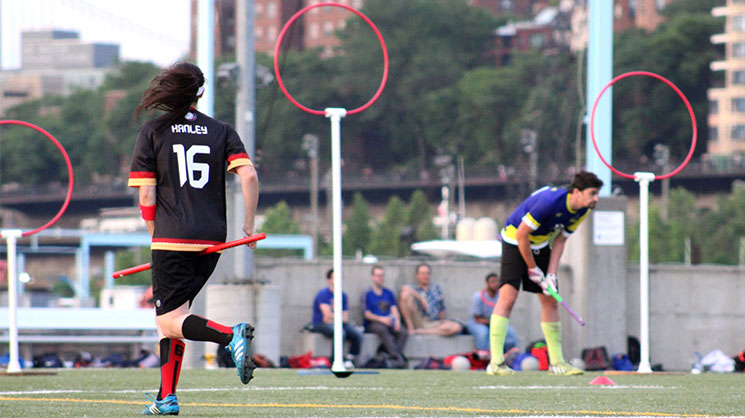When the English writer J.K.Rowling published ‘Harry Potter and the Philosopher’s Stone’ in 1997, the first novel of the saga of Harry Potter, would not have perhaps imagined that in the future the Quidditch, magical game that takes place on horseback of flying broom handles, described there for the first time, would become a true sports discipline.
Special… Quidditch!

And today, twenty-one years after the book and seventeen years after the film in which we saw Hogwarts’ students try their hand at the fantasy Quidditch for the first time, Italy is even hosting the fourth World Cup quidditch: in Florence, from June 27 to July 2.
The Muggle Quidditch: history
Invented in 2005 with an intra-mural league at Middlebury College in Vermont, the quidditch is a sport in which two teams of seven players compete on a field of grass surface.
The game is obviously inspired by the fantasy quidditch of the Harry Potter saga, and for this is called ‘muggle quiddich’ (played, that is, by those who have no magical powers: ordinary mortals). The rules were written by Alexander Manshel, quidditch’s first commissioner, using elements of rugby, dodgeball, football and street children’s games.
Since 2017, international tournaments have been held, with different definitions, most recently in July 2016 the IQA Quidditch World Cup in Frankfurt, Germany, with 23 national teams from all continents, and in March 2017 the fifth edition of the European Quidditch Cup in Machelen, in the province of Antwerp, Belgium, with the participation of 32 teams from 15 different European countries.
The quidditch in Italy was born in December 2011 when Michele Cabassi translated the regulation in force at the time and gave visibility through a facebook page. The first Italian teams are born and begin to participate in local tournaments in 2012.
In 2013 the “Associazione Italiana Quidditch” (AIQ), affiliated to IQA, was founded to promote and manage the quidditch in Italy.
In 2015, Italy hosted the first edition of the IQA European Games, in Sarteano, in the province of Siena; in May 2017, the fourth national tournament (now the “Italian Quidditch Cup”) was held in Brindisi; in this month of May, the fifth national tournament (second “Italian Quidditch Cup”) was held in Rome.
The rules
The rules of sport have been codified by the International Quidditch Association (IQA).
The field of play has a size of 55 x 33 meters, with the ends in a semicircle, and with an extension around, reserved for players and free of obstacles, of 77 x 44 meters: the limits of the field, if you play on land intended for other sports (football, rugby) can be bounded by cones or pins.
Along a “goal line” drawn in the two opposite half of the field, three circles of equal size are placed on rods of different heights.
There are seven players per team: three “chasers”, two “beaters”, a “goalkeeper” and a “seeker”.
So there are different roles and also different aspects of the game that interact with each other.
First, the snitch is a prey that, once captured, determines the end of the game. This is a tennis ball, inserted in a sock that is hung on the shorts of the snitchrunner: he is a character independent of the teams, dressed in gold or yellow, who enters the field 17 minutes after the start of the game and must move on the field of play trying to prevent the snitch is captured: for this purpose can physically interact with all players to prevent them from touching it. Its capture is worth 30 points and determines the end of the game.
Meanwhile, the chasers and the goalkeeper pass the quaffle, a volleyball ball slightly deflated to be grabbed with one hand. The goal is to score a goal in the rings (hoops) of the opposing team: the goal can be scored both by throwing and accompanying the ball into the hoop, both on one side and on the other; each goal is worth 10 points.
A third aspect of the game is the bludger, consisting of three dodgeball balls, available to beaters who use them to hit opposing players. The affected player must leave any plugs in his possession, move near his hoops and touch one of them before returning to the game.
It should be added, finally, that all players are required to hold a broom between their legs, as a symbolic reference to the fantasy game, but also as a handicap to force them to use only one hand to handle the ball. The broom, which can also be represented by a simple stick with or without the “tail”, has minimum and maximum dimensions determined.
The duration of the game is not predefined, being determined by the capture of the snitch: usually it does not exceed 30 minutes; the victory is assigned to those who have more points at the moment in which the snitch is captured.
The Four Maximum Gender Rule
The concept of inclusiveness in the quidditch game is expressed by the rule of 4 players of the same genre, where the genre is chosen by the player and can be different from the biological one. That is the rule:
A quidditch game allows each team to have a maximum of four players who identify as the same gender in active play on the field at the same time.
A. Including the seeker when released, a team may not have more than four players who identify as the same gender in play.
B. The gender that a player identifies with is considered to be that player’s gender.
C. In the event that a team cannot field a full team as fielding a full team would cause that team to exceed the gender maximum due to injury or players receiving red cards, the team may continue to play with fewer than 6 or 7 if after the seeker floor has ended) players, with the missing player(s) not counting toward the gender maximum.
The Italian Quidditch Association, has proposed to integrate the rule with the “Two/three minimum complementary rule”: the spirit of the rule is not to exceed the maximum of 4 players belonging to the same genre (freely chosen), but to ensure the presence on the field of at least 2 players for each genre (deductible from the documentation issued by the country of origin of the player and not necessarily coinciding with the biological sex of birth: in Italy, for example, the demographic adjustment of the genre is allowed by Law 164/1982). This supplementary rule will be tested during the Italian Cup Quidditch 2018 without the official approval of the International Quidditch Association, with which a dialogue is underway to introduce this rule as an amendment to the Italian Rulebook for the next sporting season.
The World Quidditch Championship
Therefore, the spaces around Artemio Franchi in Florence, where at least five fields will be created, will host the six days of the sport inspired by the Harry Potter saga, under the aegis of the International Quidditch Association (http://iqaquidditch.org/) and in collaboration with Human Company and the Municipality of Florence.
The World Quidditch Championship (IQA World Cup) is the international tournament played by the sports federations that are members of the International Quidditch Association, the international federation that heads the sport of quidditch.
The championship has been held every two years since the Oxford 2012 edition, and today holds the title of world champion for the Australian national team, which won in Germany in 2016.
In Florence 31 participating countries are expected, whose athletes and staff will be hosted in the new Firenze Camping in Town; it will be the largest tournament in the history of this sport.
If the official competitions take place in the Campo di Marte area, the opening ceremony on 27 June is scheduled in the historic centre, along with a series of side events inspired by the world of Hogwarts with themed guided tours and treasure hunts.
Rebecca Alley, Executive Director of IQA, said Florence has been chosen for its history, beauty, accessibility and support of IQA partners. “To have the opening ceremonies in a historic square and be able to make our athletes play at the highest levels in the heart of an internationally renowned site like Florence, is an incredible opportunity for both our athletes and volunteers who will make it truly world cup, both to make the profile of the sport higher.
Harry Potter: The Exhibition
From 12 May to 9 September “Harry Potter: The Exhibition” will be open in Milan, at the Fabbrica del Vapore.
On 1,600 square metres of exhibition you can see materials inspired by Harry Potter movie sets with authentic costumes, props and fantastic creatures from the films. Among the settings, the common room and the dormitory of Gryffindor, the Potions and Herbology classrooms, the Forbidden Forest, set up with original objects.
The Quidditch is present not only with objects and costumes, but also with an interactive moment, in which the visitor can enter the field and launch a quaffle.
The exhibition, which has already toured the major cities of the world, is organized by Warner Bros. Entertainment and, for Italy, in collaboration with GES, D’Alessandro and Galli, Sold Out and Encore.
Filmography / Bibliography
Quidditch’s fantastic invention appears for the first time in J.K.Rowling’s book “Harry Potter and The Philosopher’s Stone”(1997), and then in 2001 with the homonymous film transposition of Warner Bros.
Quidditch appears in five of the eight Harry Potter films. Some Quidditch subplots, such as Ron’s Keeper storyline in Order of the Phoenix, were cut to save time in the films.
• The Philosopher’s Stone (novel 1997, film 2001)
• The Chamber of Secrets (novel 1998, film 2002)
• The Prisoner of Azkaban (novel 1999, film 2004)
• The Goblet of Fire (novel 2000, film 2005)
• The Order of the Phoenix (novel 2003, film 2007)
• The Half-Blood Prince (novel 2005, film 2009)
She has also “codified” the history of Quidditch in the book “Quidditch Through the Ages”, first mentioned in “Harry Potter and The Philosopher’s Stone” as a fantasy object, but then actually published in 2001 for charity.
Videogames
“Harry Potter: Quidditch World Cup” is also a video game produced by Electronic Arts. The player participates in the Hogwarts Quidditch Cup (to which the families of Griffindor, Hufflepuff, Ravenclow and Slytherin are admitted). Then the game allows you to enter the Quidditch World Cup (between the United States, England, France, Germany, Scandinavia, Japan, Spain, Australia and Bulgaria).
The game is quite elementary, with rules similar to those of basketball and partly baseball. According to the reviews, the game looks good graphically, but with the limit of being interesting only for fans, and finally, once you’ve learned the necessary tactics, it’s too easy.










